
Humphreys' $2.4 Million Contribution Funds Complex Litigation Center
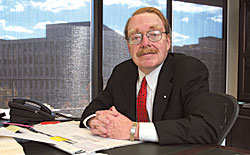 |
|
James Humphreys, JD ’79, in his Washington, D.C., office
|
Catastrophic personal injury, wrongful death, product liability, employment discrimination…James Humphreys, JD ’78, has seen it all, successfully representing tens of thousands of victims during his 25-year legal career. Now, the prominent West Virginia attorney is determined to make a difference on an even greater scale. This fall, he donated one of the largest sums in GW Law School history to his alma mater to establish the Humphreys Complex Litigation Center, aimed at enhancing the legal community’s ability to deal with the ever-growing number of mass and complex litigation cases in the United States.
“Historically, law has been practiced one-on-one, and that remains the paradigm, but in the 21st century, as makers of products, sellers of securities, and polluters of the environment cause injury to hundreds or thousands of people, the courts can’t possibly deal with their cases one at a time,” Humphreys says. “They would overwhelm the system. For justice to be effective, issues involving large numbers of injured people or highly complex issues must be addressed through mass and complex litigation.”
According to Humphreys, the center’s mission is to provide federal and state judges, court administrators, lawyers, and public policy makers with comprehensive information about complex litigation—a field that is still foreign to many. “Increasingly, cases require more than the traditional one plaintiff/one defendant/one judge courtroom,” he says. “In the last couple of decades, more than half a million asbestos claims have been filed by people who have been injured or whose family members have been killed through no fault of their own. Thousands of people have been financially damaged by corporations such as Enron, WorldCom, and Arthur Andersen. The court system is set up for when Smith hits and injures Jones—not for when he injures 100,000 Joneses, generating thousands of contradictory statements at the intersection.”
Through the Complex Litigation Center, Humphreys aspires to educate judges and the legal community on the most successful ways of resolving mass claims quickly and fairly to both parties. “There’s a real need to instruct them on everything from the mechanics of what’s needed in a complex litigation courtroom to how scheduling and constitutional issues and challenges have been successfully resolved in similar cases,” he says. “There have been innovative and knowledgeable judges in several states who’ve shown how readily and relatively easily these types of cases can be administered fairly,” Humphreys continues, pointing to recent mass litigation cases in Mississippi, West Virginia, and Maryland. “It’s our goal to provide the facts and analysis necessary to enable all 50 state judicial systems, as well as the federal system, to provide justice to injured parties in complex litigation cases.”
Humphreys is the perfect person to lead the way, as he knows the mass and complex litigation field inside and out. In 1979, he founded his Charleston-based law firm, James F. Humphreys & Associates, now one of the nation’s most prominent firms focusing on product liability, toxic torts, and wrongful death cases, with a special emphasis on asbestos and toxic injury litigation. He has met with great success over the years, filing successful class actions on behalf of some 11,000 people suffering from asbestos-related illnesses and winning compensation for victims injured by dangerous and defective products, occupational exposure to toxins, and employment discrimination.
“My firm represents clients in 26 states, and as we go from state to state, I’ve seen many judges who’ve had no experience with mass and complex litigation,” he says. “The center will help them by examining how various courts attempt to resolve mass disputes and what success their attempts meet with,” Humphreys says.
The center recently conducted meetings in Washington and San Francisco aimed at gathering input from federal judges, attorneys, and members of the academic community on the topic. “There was a consensus of opinion that there needs to be in both the federal and state courts a center that collects, analyzes, and publishes information on the course of mass and complex litigation,” Humphreys says. “I’m glad to be in the position to help GW Law School make that center a reality.”
Philanthropy is nothing new to Humphreys. He established a GW Law School scholarship fund for deserving students several years ago and funded a new student lounge in Stockton Hall and a spacious amphitheater classroom in Stuart Hall in 2003. “I feel a great sense of gratitude and some sense of obligation to the Law School because the excellent legal education I received at GW has allowed me to pursue my interests and take care of my family,” he says. “You just can’t keep drawing out without putting something back in the well. I’m happy to do it.”
—Jamie L. Freedman
For the Good of the People
$2.2 Million court settlement money earmarked for GW Law Clinics
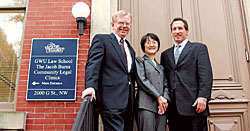 |
|
Interim Dean Roger Trangsrud with Associate Dean for Clinical Affairs Carol Izumi and attorney Philip Friedman, who arranged for the contribution to the clinic.
|
If you live in the Washington area you may have read about Philip Friedman and his efforts to fight big cable television companies. His quest to recoup millions of dollars in late fees from cable giants such as Comcast has made local and national news. Now it makes GW Law news, as part of the money named in the settlement will be going to benefit GW Law’s Jacob Burns Community Legal Clinics.
The case, which Friedman filed in the District of Columbia in 1996, recently settled. As part of the class action settlement, GW’s legal clinics will receive about $2.2 million dollars from a “cy pres” fund from the case.
It all started for Friedman one day when a friend complained about always having to pay late fees to his cable company no matter when he paid his bill. “Ignorance being bliss,” Friedman says, he thought it would be interesting to file a class action lawsuit to right the wrong he heard about from his friend.
Friedman first filed the case against cable company TCI (Comcast’s predecessor) in 1996. Late fees affected 25 to 30 percent of subscribers every month, he says. “From only 100,000 subscribers, the cable company was making about one and a half billion dollars a year from late fee collection in the District.”
Friedman challenged the cable company, citing violation of a liquidated damages clause in the consumer contract, which says that the consumer cannot have a penalty in the contract.
“We took the case to trial and we won,”he says.
Friedman also brought suit to several companies across the nation. The case in Washington, D.C., was his first but was the last to settle.
“I realized midway through prosecuting the case that this was going on all across the country, and the cable companies were all engaged in this same practice. I filed suit all across the country pursuing the same theory.”
After the District, he filed cases in Maryland, Indiana, Illinois, and Texas. The cases in Maryland, Illinois, and Indiana went all the way to trial.
He was particularly happy with the outcome in Maryland, where the case went to the Court of Appeals. “They determined that my theory was entirely correct—you could not charge any more than the rate of interest, so the late fee should have been 10 cents, not five dollars.”
The cases in Maryland ended up returning more than $33 million to consumers.
The D.C. settlement, from which GW Law will benefit, settled at $13.7 million.
“As part of the settlement procedure, there was an opportunity for all subscribers who submitted claims to get back all of their late fees through the official claims procedure. Unfortunately, most people just don’t take advantage of the process. Yet the wrongdoer shouldn’t be able to keep the money. Cy pres is a concept that says, ‘Let’s find the next best use of the money.’ It comes from probate law.”
After the claims procedure was com-pleted, there was close to $9 million left, so Friedman went to court with Comcast again to argue that four D.C. legal clinics should receive the money: D.C. Law Students in Court, the Legal Counsel for the Elderly, and the law school clinics at Georgetown and George Washington.
“I made the argument to the court that this was a case that was about protecting the interest of D.C. consumers, and also this case was exceedingly important in terms of determining the remedies under the D.C. consumer protection statute, as this case set the standard.
“The money should go to institutions that protect the consumers in the District of Columbia and give access to those in court who are least able to afford it. This was a community that was grossly underserved in terms of having access to courts and legal services. These institutions in particular would help protect those rights.”
Each of the four D.C. clinics Friedman chose will receive about $2.2 million. “What’s so great about it is that the money obviously goes to vindicate consumer interest. Here is money that individually may not have meant a lot to the people who had the right to get their five, 10 or 50 dollars, but suddenly these small sums of money aggregate into large sums of money that really can make a substantial difference in people’s lives.”
Friedman says he also wanted to underscore the importance of class actions in bringing real benefits to the people they are designed to protect. “You always hear that all the money goes to the lawyers and the consumers get nothing. This is a real example of how class actions really do work. It not only stopped a predatory practice, but it took the money and used it for the longer term benefit of preventing further predatory practices.”
Associate Dean for Clinical Affairs Carol Izumi knows the impact the money will have on the clinics will be great. “Our clinical program is tremendously grateful to Phil Friedman for naming us as one of the cy pres beneficiaries,” she says. “The award acknowledges the 30-plus years of legal services we have offered to D.C. residents and will allow us to have an even greater impact on the community in the future.”
Friedman, a graduate of Stanford Law, came to the Washington area several years ago with the intention of going into politics. A stint on the Clinton campaign in 1992 cured him of his political bug, he says. He has been a member of the Washington and Maryland legal communities since the late 1980s and runs his private practice out of his D.C. office.
Friedman continues to handle class action cases, mostly related to consumer fraud, as well as some election law-related cases. He notes that this type of work is an important area for lawyers but is one that requires time and patience in dealing with high-stake cases that usually involve large sums of money and a great deal of complexity. He makes this observation: “My two high-school age sons, now 14 and 16, were both wearing feet pajamas at the time I began the D.C. case, which just settled. And now my oldest is driving.”
Friedman admits he has had to spend a lot of time in court. “I’ve had to take a lot of them to trial which is not typical.”
Friedman has no plans to stop taking on class action lawsuits. “They’re fascinating. They have a David and Goliath aspect to them,” he says. “They are really the last vestige of protection for consumers. Corporate America knows that and has quite deliberately attempted to give all class suits a bad rap. By running the sheriff out of town, there will be nothing left to hold corporations accountable for the systemic fleecing of consumers.”
“Hopefully,” says Friedman, “this case will underscore the benefits and the importance of class action protections.”
Conference Center Named for Former Dean
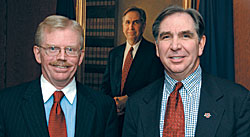 |
|
Interim Dean Roger Trangsrud stands with former dean Michael K. Young in front of Young’s portrait, which was unveiled at the Law School this fall during a dedication of the conference center in Young’s name.
|
When former GW Law dean Michael K. Young bid farewell to Washington in August to become president of the University of Utah, he left behind a thriving Law School and many friends. As a lasting tribute to his exceptional vision and leadership, the Michael Young Faculty Conference Center was dedicated at GW Law on Nov. 12, thanks to the generosity of advisory board members and law faculty, who committed $250,000 toward the project.
Spacious and versatile, the conference center was designed to accommodate a wide variety of programs and events—from formal conferences and symposia to faculty meetings and stand-up receptions. State-of-the-art audio-visual equipment, built into the walls, ceilings, and podium, provides multimedia presentation support at the touch of a button or click of a mouse.
“This conference center is a very appropriate way to honor Mike because it symbolizes his leadership—inclusive, expansive, and visionary,” says James W. Ziglar, JD ’72. “Mike did so much to advance GW Law School. He brought new energy, creativity, quality, and vision to the school. His legacy will extend far into the future and he made all of us proud to be part of the GW Law School family.”
David R. Berz, JD ’73, who joined Ziglar in raising funds for the project, concurs. “Mike Young was a terrific ambassador for GW Law School and a very talented communicator, so this is a terrific way to highlight his contributions as dean. The conference center is a place where the rich exchange of ideas about the direction of the Law School will take place, and I’m glad that Mike Young’s name will be prominently featured there.”
Chairman of the Dean’s Board of Advisors Richard W. Blackburn, JD ’67, provided important leadership in helping to make the Michael Young Faculty Conference Center a reality. “Mike’s short tenure as dean had such a remarkable impact on the Law School,” he says. “He upgraded our standards, upgraded our national presence and reputation, greatly expanded our facilities, and brought the alumni back to meaningful engagement with the Law School. The center will be a living reminder of what a significant impact quality leadership can have on an institution.”
Young says that he’s deeply honored by the gesture. “It is impossible to describe how much it means to me that the Law School has chosen to attach my name to the Faculty Conference Center,” he says. “At the heart of any great law school is an exceptional faculty, and The George Washington University Law School’s is among the greatest. The intellectual vibrancy of this remarkable faculty was constantly apparent to me, as ideas and results of innovative and imaginative research bounced off the walls on a daily basis.
“What a wonderful privilege it was to be a member of GW Law School’s faculty, and now, when the professors enter the conference room to have one of those extraordinary conversations about the law and its meaning in our national life, I will be there with them in some small way. It means more to me than I can possibly say.”
—Jamie L. Freedman
Loyalty for a Lifetime and Beyond
$1 million gift will support the faculty
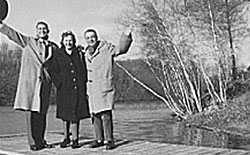 |
|
Fred Stevenson (far right) with Finley “Goose” Goslin, a fraternity brother of Stevenson’s, and Helen Goslin, who also attended GW, at Lake Mohawk, N.J., in November 1959
|
It would have made a great movie. For 70 years, Fred Stevenson, BA ’34, JD ’37, wrote long, monthly letters on life to his GW friends, Finley and Helen Goslin. Helen, the correspondent of the couple, would faithfully write back to Stevenson each month, and then eagerly await his reply. “We always looked forward to Fred’s letters, which were generally four pages long and full of news about our GW friends,” she says. “We lived all over the world, as my husband was a pilot with Pan American, but never lost contact with Fred. He kept in close touch with everybody. GW was important to him and always stayed that way.”
Stevenson’s intense loyalty and deep connection to his alma mater will now live on in perpetuity. When he passed away earlier this year at the age of 93, he left the entire contents of his estate to GW Law School, ensuring a lasting legacy for future generations. Never married, Stevenson designated in his will that his estate be used to establish a faculty research fund at the Law School.
“He wanted to see future GW students benefit as much as he did from the University,” says Richard A. Lash, LLM ’91, the executor of Stevenson’s estate. A shareholder at Buonassi, Henning & Lash in Arlington, Va., Lash is the grandson of Stevenson’s lifelong best friend, Katherine Bour Devonald, who attended GW. “I saw him often when I was growing up, and he always said how much he loved GW and valued his GW education,” Lash says.
Stevenson’s legacy of support to his alma mater mirrors the strong emphasis that he placed on GW throughout his life. A native of Atlantic City, N.J., Stevenson earned an undergraduate degree in government at GW, as well as his law degree. He quickly became involved in campus life, serving as social chairman of the Tau Sigma Rho fraternity and forging many deep friendships. Upon graduating, he remained in the Washington area and carved out a successful career as a government attorney, working for decades at the Federal Trade Commission and the Consumer Products Safety Commission.
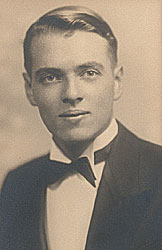 He cherished the friendships he made at GW, keeping in close touch with many fraternity brothers and classmates for the remainder of his life. “Everyone knew Fred at GW, and he had no enemies, only friends,” says Helen Goslin. “Every time we visited Washington, he would get our group of GW friends together and throw a party. He was very personable and outgoing, and loved to have people around him.”
He cherished the friendships he made at GW, keeping in close touch with many fraternity brothers and classmates for the remainder of his life. “Everyone knew Fred at GW, and he had no enemies, only friends,” says Helen Goslin. “Every time we visited Washington, he would get our group of GW friends together and throw a party. He was very personable and outgoing, and loved to have people around him.”
A keen world traveler, Stevenson loved good parties, cooking, and plants, and was known for his thoughtfulness and generosity. “He never forgot my birthday and walked through snow and ice to bring my wife soup when she wasn’t feeling well,” says Joe Shepherd, Stevenson’s long-time friend and neighbor in northern Virginia.
According to Shepherd, Stevenson talked about GW through the final months of his life. “The University was always on his mind,” he says. “Fred was extremely loyal to GW and thought the world of it.”
—Jamie L. Freedman